Tom Cunliffe was aboard Eleonora, an exact replica of the record-breaking schooner Westward, for this season's RORC Caribbean 600.
One of the great wonders of sailing is that, no matter how wide our experience or how long we’ve been at sea, none of us has seen it all.
Take me, for example. When asked, I generally say that an extended life on the water has put me at the helm of everything from a Firefly dinghy to a square-rigged ship and filled in most of the gaps between, but at the end of February this year, I rediscovered the schooner.
The first boat I sailed for a living was the schooner Hindu out of Provincetown, Massachusetts. Designed for the Bermuda Races, she gave me a good start.
Later I served aboard a working trader, then it was Olin Stephens’s 1930s masterpiece Brilliant under the late Captain George Moffett. Fine vessels all, but none prepared me for the impact of sailing aboard Eleonora in the RORC Caribbean 600 race.
Eleonora was launched in 2000. She is a straight replica of the 135ft, 214 ton Herreshoff schooner Westward.
Under the command of her Scottish captain, Charlie Barr, Westward swept across the Atlantic in 1910 to take 11 1sts in 11 starts against the smartest Europe could produce.
This is Eleonora’s heritage. She was born to race, but sprints around the cans mean an exhausting workout for crews handling spinnakers and gollywobblers the size of a supermarket car park; the boat is hardly into her stride before the interesting sails are dropped for the next beat.
The RORC Caribbean 600 is different. The race could have been dreamed up for schooners. Set across the north-east tradewinds among the islands around Antigua, it features reaches up to 150 miles long, a beat or two and the odd run that, with luck, shouldn’t be too extended.
Some 600 miles of glorious sailing against some of the world’s top boats, old and very new, is a proposition no sailor could turn down, so when the call came to join Eleonora I threw my winter diary out of the porthole.
I arrived three days before the start to find the yacht stern-to in Nelson’s Dockyard flying the Royal Yacht Squadron burgee of my chum David Aisher, a friend of the owner. The crew of 28 under Captain Brendan McCoy were a mix of David’s party and professionals.
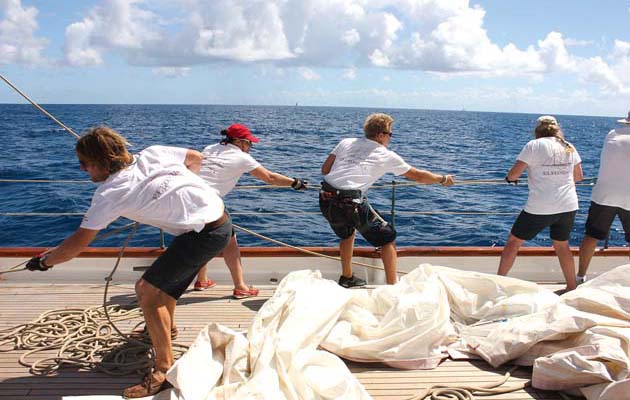
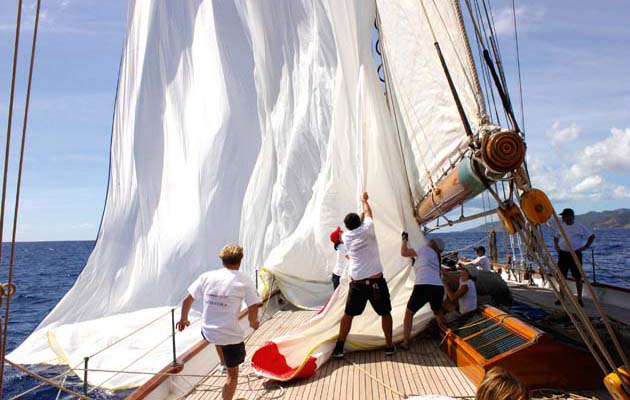
Levels of competence ranged from the guests – keen, but of mixed gaff-rig experience – to the tough, fit seamen and women of the nine permanent crew, augmented by a group of pros brought in to provide reliable deck work, add tactical support to the skipper, save the amateurs from killing themselves and help train us into a team.
One thing was sure: with blocks the size of your head flying around and 12,000sq ft of sail either to drive you or to flatten you with extreme violence, there was no space for passengers.
Above all, what a 200-ton schooner needs is wind. Winter in the Caribbean more or less guarantees cracking north-east Trades, but this year the unthinkable happened: a cloud was drifting into the path of the sunshine. A long, trailing front on holiday from the North Atlantic had been threatening the Trades.
A classic duel
On start day the front was poised for action. By day two it was forecast to generate a slack low pressure system and perform tricks with the wind you’d normally only see coming out of a conjuror’s hat with the white rabbit. The outlook for the heavy classics was far from ideal.
With light winds predicted for much of the race, we couldn’t compete against today’s featherweight flyers, but we had a private contest on with Adela, the other schooner. Adela has a sexy modern rig and transcends even Eleonora’s 160ft of sparred length.
She is usually faster over the water, but the handicappers were on the case. If the wind held up and we did our boat justice we might just pip her in the final results.
Tacking a gaff schooner under full sail is a complex business, which was going to make any starting gun shenanigans best avoided. A few years back Eleonora’s two topmasts went over the side after a runner was missed; the prospect of fast-turning race boats calling starboard on us as we beat up to the line must have brought Jason Beken, our first mate, out in a cold sweat.

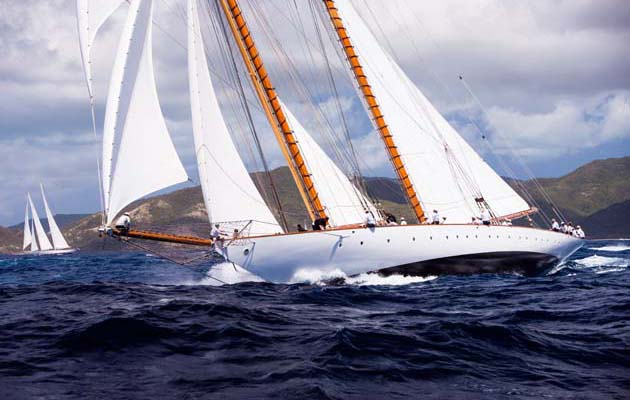

Adela’s sail plan is simpler than Eleonora’s, so the two skippers agreed on a start-line policy. Adela would cross the line first on the safer offshore tack with us close behind. Both giants would hang back to keep clear of smaller craft.
The plan worked and away went both schooners along the south coast of Antigua, close-hauled in a brisk breeze from the east. As we thundered along well heeled, a hissing sound from our weather quarter announced the arrival of Phaedo3 and Maserati, the two flying MOD70 trimarans that had started after us.
With a whoop of sheer delight, their crews shot past us as if they were in F1 cars seeing off a vintage Bentley and were gone from our lives. As for Adela, we’d given her a minute or so for safety, but with waterlines of around 100ft, 600 miles offered plenty of time to make it up.
Eleonora could have done with a few knots more from the wind, however, so Adela soon opened a commanding lead. We stood out to sea on one long board to avoid manoeuvres, because coming about in a traditional racing schooner involves a lot more than just tacking the headsails.
The main jackyard topsail with its massive 60ft luff spar slots across with the mainsail, but the fore gaff topsail and the fisherman staysail stand in the area between the masts. They have to be set to leeward of the triatic and topmast stays, so they must be dropped before the boat can be brought to the wind.
The foremast hands gather on the downhill side as the topsail halyard and sheet are let go. Four or five grab the sail as it is lowered and sort it out for a quick rehoist on the other side.
Meanwhile, the midships team spread out along the deck under the fore boom ready to smother the fisherman as its two halyards are eased away. For readers who don’t know about fishermen, this four-cornered powerhouse is set flying.
The throat hoists to where the foremast is doubled with the topmast. The peak goes to the main topmast head. The sheet leads from the clew to a cheek block well aft on the main boom and the tack downhaul is set up at the foot of the foremast.
All sorts of expensive repair bills await mistakes, but somehow the beast is smothered and shoved under the boom for hoisting when she fills away on the new tack. With the upper sails on deck, the helm can spin the wheel.
Apart from three headsails and the size factor, the only further complication is the two sets of runners. These are intimidating in their sheer weight.

The three headsails are called by the bowman from the bowsprit end. He uses sign language because nobody shouts on Eleonora except, occasionally, the mate when the spinnaker sheet crew needs a nudge. Each sail gets a number. Jib topsail, 1; jib, 2; staysail, 3.
The bowman, known mysteriously as ‘The Nipper’, even though he is actually the mate of the schooner Elena and on loan to us for the race, holds up one finger, then signs to heave in the jib top until he is satisfied. Then it’s two fingers and so on.
He doesn’t slam the sails in hard immediately, he eases them a touch while the schooner gathers way. Once she’s making ten knots or so, she comes up slowly and his trimmers harden in until she is sailing at around 45° to the true wind.
As soon as we rounded Antigua and eased sheets for Barbuda, the fisherman gave way to the monster gollywobbler. This is basically a giant fisherman that fills the gap between the masts completely.
It overlaps the mainsail substantially and its power is fearsome. The ‘golly’ was followed by the new asymmetric spinnaker which set like a dream to the great satisfaction of the mate and especially the skipper.
The wind began playing tricks as night fell between Barbuda and Nevis. Every so often a foul-up aloft would mean one of the young men would fly up on a harness to perform unthinkable acts of daring, including that particular ‘favourite’, the walk to the extreme end of the gaff, where a topsail sheet had whipped around the spar – every gaff sailor’s nightmare, and there’s no other way of clearing it short of dropping the whole lot.

Along the coast of St Maarten.
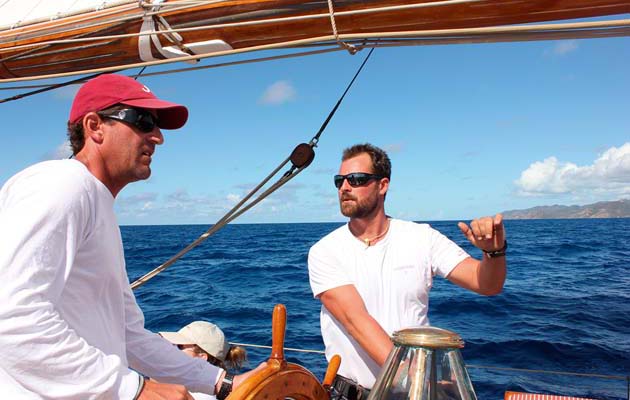
Rounding Nevis, the wind fell away and swung into the west, bang on the nose. We beat past the brightly lit shoreline in the dark and fetched off towards Saba 50 miles to the north-west as the watch changed at 0200.
Six hours later we were reaching steadily towards St Maarten under spinnaker and golly. Up to weather the blackest of squalls was limbering up and the rain started.
The front arrived like an avalanche. We were hardly kitted up before it was hammering down in a solid wall of water.
The wind came on with real spite in a heartbeat and all hands were tackling the gollywobbler. Along with ten others, I was scrabbling at its craziness from the windward side while one of the professionals, Colin, was hammering it into submission from leeward. The punch I received through the canvas would have done justice to Mike Tyson and I sported a black eye for the rest of the trip.
After the front, the weather went completely insane with wind 180° adrift from normal. In a typical year, boats reach past the island of St Maarten then hack up to the eastern end of the Anguilla Channel.
As the rain backed off we could see the bowsprit end again and the wind kicked in outrageously from the south-west, leaving us beating up to what should have been the leeward end of St Maarten. Here, at last, we bore away and set every stitch we had.
All hands tumbled out on deck because this was what we’d all come for. As we scorched down that sound at 14 knots, 50ft race boats swam briefly into our sights and were left bobbing in our wake as we surged along, rail down, rig roaring for joy.
While it lasted it was glorious, but all things must end and by the time another star-carpeted night had wheeled by we were becalmed. We had found the hole in the pressure gradient.
A whole fleet of yachts was effectively parked up between Guadeloupe and the Saintes. The prognosis for schooners was dismal.
Modern yachts with no wind in a slop of sea can strap in the main and suffer little more than annoyance. For us, the racket from aloft was deafening as the gaffs rolled and screamed.
We took in the fisherman and bagged the spinnaker, but still the clatter went on. The jackyarder was suffering most with its huge club yard being munched by the gaff spans at every lurch of the rig yet, had we dropped it, all progress would have ceased.
A light breeze was due to show up the following afternoon, but even if we waited for it, we wouldn’t be back in time for the prizegiving. The damage the yacht was suffering was painful, so we dropped everything and called it a day. Adela retired shortly after us.
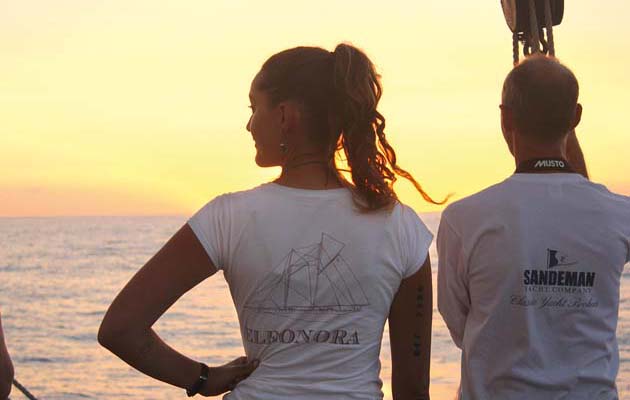

With the team spirit we’d built up, everyone on board was disappointed, but the weather is what it is, and sometimes there’s more to life than winning a race. It was enough to be at sea on a world-class piece of history with a crew whose spirit reignited our faith in the future.




